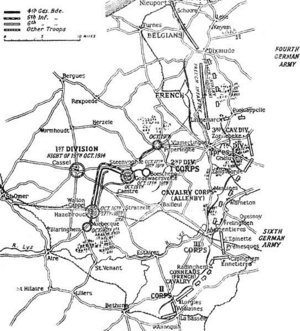First Battle of Ypres facts for kids
Quick facts for kids First Battle of Ypres |
|||||||
|---|---|---|---|---|---|---|---|
| Part of the Western Front of the First World War | |||||||
|
Positions of the Allied and German armies, 19 October 1914 |
|||||||
|
|||||||
| Belligerents | |||||||
| Commanders and leaders | |||||||
|
|||||||
| Strength | |||||||
|
5,400,000 | ||||||
| Casualties and losses | |||||||
|
|||||||
| 134,315 German casualties in Belgium and northern France, 15 October – 24 November | |||||||
The First Battle of Ypres was a major battle during the First World War. It took place near the town of Ypres in Belgium, from October 19 to November 22, 1914. This battle was part of a larger series of fights called the First Battle of Flanders.
In this battle, armies from Germany, France, Belgium, and the British Expeditionary Force (BEF) fought fiercely. The fighting stretched from Arras in France to Nieuport on the Belgian coast.
The battles around Ypres started after what was known as the "Race to the Sea." This was when both German and Allied armies tried to outflank each other. They wanted to get around the end of the enemy's lines to gain an advantage.
North of Ypres, fighting also happened in the Battle of the Yser. This battle involved the German 4th Army, the Belgian army, and French marines.
What Was the First Battle of Ypres?
The First Battle of Ypres was a long and tough fight. It happened on the Western Front of the First World War. This front was a line of trenches and battlefields that stretched across Belgium and France.
The battle is often divided into several stages. It started with an "encounter battle" from October 19 to 21. This means armies met and fought without much planning.
Then came the Battle of Langemarck from October 21 to 24. Other battles, like those at La Bassée and Armentières, also took place nearby.
A major German attack happened on October 29, leading to the Battle of Gheluvelt. The final big German push was the Battle of Nonne Bosschen on November 11. After this, smaller local fights continued until late November.
Who Fought in the Battle?
The main groups fighting were the Allied forces against the German Empire.
The Allied forces included:
- Soldiers from France
- Soldiers from Belgium
- The British Expeditionary Force (BEF) from the United Kingdom
The German forces were made up of the German 4th and 6th Armies.
Leaders on the Allied side included Joseph Joffre and Ferdinand Foch for France, King Albert I for Belgium, and Sir John French for the British.
On the German side, key commanders were Erich von Falkenhayn, Albrecht of Württemberg, and Rupprecht of Bavaria.
What Happened During the Battle?
The Allied forces, including the British, Belgians, and French, tried to advance. However, they made very little progress beyond Ypres.
The German armies also tried to gain ground. They captured small areas but at a very high cost to both sides. This happened during the Battle of the Yser and further south at Ypres.
Erich von Falkenhayn, the head of the German General Staff, then tried a new attack. His goal was to capture Ypres and Mont Kemmel. This offensive lasted from October 19 to November 22.
Neither side could move enough soldiers quickly enough to win a decisive victory. By November, both armies were very tired. They were running low on ammunition, and many soldiers were losing hope. Some infantry units even refused orders.
Why Was the Battle So Difficult?
The battles in Flanders became very static. This means the armies stopped moving much and just fought from fixed positions. It turned into a battle of "attrition," where each side tried to wear down the other.
French, British, and Belgian troops quickly built simple defenses in the field. They managed to stop the German attacks for four weeks.
For example, from October 21 to 23, German reserve soldiers launched huge attacks at Langemarck. They suffered massive losses, sometimes up to 70 percent of their troops, but gained little ground.
The weapons of the Industrial Revolution, like powerful artillery and machine guns, made it very hard to attack. These weapons were very effective when used defensively from fortified positions.
Armies could also supply themselves and replace injured soldiers for a long time. This meant battles could go on for weeks.
What Was the Outcome?
The First Battle of Ypres ended without a clear winner. It was an "indecisive" result. Both sides had fought hard but neither achieved their main goals.
The Germans had 34 divisions fighting in Flanders. The Allies had 12 French, 9 British, and 6 Belgian divisions, plus marines and cavalry.
After the battle, General Falkenhayn thought about Germany's strategy. He realized that trying to completely destroy France and Russia was too much for Germany.
He then decided on a strategy of "attrition." This meant making the war so costly for the Allies that one of them would eventually give up and make a separate peace. If one country left the war, Germany could then focus its forces on the remaining enemies.
Images for kids
-
Fanciful painting of the 2nd Battalion, Oxfordshire and Buckinghamshire Light Infantry, Nonne Bosschen, defeating the Prussian Guard, 1914 (William Wollen)
See also
 In Spanish: Primera batalla de Ypres para niños
In Spanish: Primera batalla de Ypres para niños








